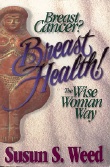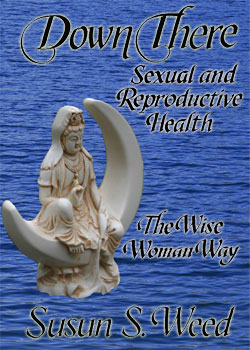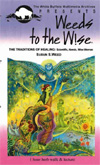www.susunweed.com
Herbal Adventures with Susun S Weed
The Malvaceae -- or mallow -- family
as seen printed in www.sagewoman.com
I like to stay at home and watch my flowers bloom. And I also like to travel and see other flowers. In previous columns you've accompanied me horseback riding in the lavender fields of Provence; now I invite you to come with me to Costa Rica, where hummingbirds sip nectar in cloud forests and toucans tilt their beaks in a raucous serenade.
One of the first plants to greet me when I arrived in Costa Rica was a friendly face I knew at once: a bush of beautiful molten-red hibiscus flowers. You could say that hibiscus flowers are the emblem of the tropics. I've seen their blazing colors and protruding "tongues" throughout Hawaii, across Jamaica, lining the roads in Puerto Rico, and in the gardens of tropical paradises closer to home as well. But I wasn't thinking of any of those places as I smiled back at that grinning hibiscus in Costa Rica, then picked and ate several of its crisp, nectar-filled blossoms. Pura vida!
Eating fresh hibiscus flowers is fun, and such behavior might help prevent heart disease and lower the risk of getting cancer at the same time. Hibiscus blossoms are exceptional sources of anti-cancer trace minerals such as selenium and chromium, and flavonoids (like in green tea). Hibiscus flowers are also a good source of calcium, manganese, potassium and vitamin C. Good for the heart and just what I needed after a long plane ride.
If you're thinking, right about now, that the only hibiscus you're likely to eat is in your dreams. Surprise! You needn't be anywhere near the tropics to enjoy the benefits of fresh hibiscus. She's part of a big family -- the mallows or Malvaceae -- and some of her close sister plants live in cold places. Mallows can grow in wet places and dry ones, cold places as well as the tropics, in the valleys and high in the mountains. No matter where you live, some ever-helpful Malvaceae will find a way to live there.
Let's focus on the Malvaceae family for a moment. One of my favorite ways of learning -- and teaching -- about plants is through their families. Each plant family is a group of plants that has the same flower chacteristics. Interestingly enough, the plants in a family frequently have the similar actions and uses. Learning about a plant family, rather than just one plant, not only helps you identify more plants, it gives you an idea of how to use them.
The Malvaceae -- or mallow -- family is easy to identify and fun to use. Mallow flowers are bisexual and symmetrical, with five sepals (the green parts that protect the flower bud) and five colored petals. But, you say, many plants, like wild roses and geraniums, have five sepals and five petals. What sets the Malvaceae, or mallow, family apart? Imagine, if you will, a hibiscus blossom -- or look at a picture or drawing of one. The "tongue" sticking out of the petals is the pistil (the female part of the flower). The tip of the pistil is the stigma, and in this family it is divided into numerous fingers. Between the stigma and the ovary -- which is nestled at the base of the petals and which will ripen into a seed capsule -- is the part of the pistil called the style. Numerous fused stamens (the male parts of the flower) cluster on and around the style. This is the distinctive feature of all Malvaceae flowers.
The mallow family contains nearly 200 genera (a genus is a group of closely related plants within a family, and genera is plural of genus) -- including Alcea, Althea, Malva, Hoheria, Hibiscus, and Gossypium -- and more than 2000 species (specific plants within each genus). The mallow family includes beautiful, edible, medicinal, and useful plants such as hibiscus, Rose of Sharon, hollyhock, marshmallow, okra, jute, and cotton.
Virtually all parts of the mallows have been eaten or used as medicine including the fresh leaves, dried leaves, fresh roots, dried roots, and both green and ripe seeds. The primary effect of most mallows is to soothe and heal mucus surfaces. Overheated respiratory, digestive, reproductive, and urinary systems especially benefit. The mucilage present in the roots and seeds, and to a lesser degree the leaves, can help ease and heal irritations and infections such as sore throats, acid indigestion, stomach ulcers, ulcerative colitis, irritable bowel syndrome, bronchitis, chronic coughs, badder infections, interstitial cystitis, colds, and dry mouth. Some sources find mallow medicine helpful for those with diabetes, painful periods, and lack of menstruation.
Of course mallows are superb helpers for healing and relieving the pain of cuts, scrapes, boils, bruises, swellings, and stings. Ointments, fresh leaves and roots, and the whole plant pounded into a juicy pulp have been used for thousands of years to treat a vast array of skin problems and severe wounds. I especially like mixing chopped fresh hibiscus or mallow leaves with honey and applying this to my eyelids to relieve tired, sore, dry eyes. Works great as a facial, too!
The most common wild mallow at Laughing Rock Farm is "cheeses" (Malva neglecta). They are virtually evergreen, providing delicious greens for salads and cooking, and mucilaginous roots for healing, well into the cold months. The same is true of common mallow (Malva sylvestris). marshmallow (Althea officinalis), the one most often cited as medicinal, and whichever mallow graces your home.
An old Russian story tells of a Tartar warlord who declares he will kill a villager's child every day until his own son is cured of a persistent cough. The local wise woman digs up mallow roots, mashes them in cold water, and gives this to the boy, thus curing his cough and saving the day -- and the village children. (A Russian Herbal, Igor V. Zeven, 1997, Healing Arts.)
In addition to feeding us and giving us healing medicines, the plants of the Malvaceae family provide strong supple fibers for clothing, cordage, weaving, and housewares. Many Hibiscus and Sida species have been used these ways, but the best fibers come from other genera: Corchorus hirtus (jute), Abutilon theophrasti (chingma, Chinese jute), and one of the most important fiber plants in the world -- cotton (Gossypium species).
The roots of cotton are the exception to the rule of edibility in this family. Cotton root bark is one of the strongest abortifacients known to herbalists. I have not used it much, owing to the difficulty of finding organic cotton root, but stories of slave women chewing on cotton root to abort are plentiful.
As I swallowed the last of my hibiscus flower snack in Costa Rica and grinned back at the bush, I felt my heart open with delight and thanksgiving. Despite our problems, life is good, and our planet is an exquisite gem clothed in green blessings. Go outside now, wherever you are, and find a mallow. Can you hear old Pliny whispering in your ear: "Anyone taking a spoonful of mallows will be free of disease." Smile.
Susun Weed
PO Box 64
Woodstock, NY 12498
Vibrant, passionate, and involved, Susun Weed has garnered an international reputation for her groundbreaking lectures, teachings, and writings on health and nutrition. She challenges conventional medical approaches with humor, insight, and her vast encyclopedic knowledge of herbal medicine. Unabashedly pro-woman, her animated and enthusiastic lectures are engaging and often profoundly provocative.
Susun is one of America's best-known authorities on herbal medicine and natural approaches to women's health. Her four best-selling books are recommended by expert herbalists and well-known physicians and are used and cherished by millions of women around the world. Learn more at www.susunweed.com
For permission to reprint this article, contact us at: www.ashtreepublishing.com/contactVisit Susun Weed at: www.susunweed.com and www.wisewomanbookshop.com
Susun Weed’s books include:
Wise Woman Herbal for the Childbearing Year
Author: Susun S. Weed.
Simple, safe remedies for pregnancy, childbirth, lactation, and newborns. Includes herbs for fertility and birth control. Foreword by Jeannine Parvati Baker. 196 pages, index, illustrations.
Order at: www.wisewomanbookshop.com
Healing Wise
Author: Susun S. Weed.
Superb herbal in the feminine-intuitive mode. Complete instructions for using common plants for food, beauty, medicine, and longevity. Introduction by Jean Houston. 312 pages, index, illustrations.
Order at: www.wisewomanbookshop.com

NEW Menopausal Years the Wise Woman Way
Author: Susun S. Weed.
The best book on menopause is now better. Completely revised with 100 new pages. All the remedies women know and trust plus hundreds of new ones. New sections on thyroid health, fibromyalgia, hairy problems, male menopause, and herbs for women taking hormones. Recommended by Susan Love MD and Christiane Northrup MD. Introduction by Juliette de Bairacli Levy. 304 pages, index, illustrations.
Order at: www.wisewomanbookshop.com
For excerpts visit: www.menopause-metamorphosis.com
Breast Cancer? Breast Health!
Author: Susun S. Weed.
Foods, exercises, and attitudes to keep your breasts healthy. Supportive complimentary medicines to ease side-effects of surgery, radiation, chemotherapy, or tamoxifen. Foreword by Christiane Northrup, M.D. 380 pages, index, illustrations.
Order at: www.wisewomanbookshop.com
Down There: Sexual and Reproductive Health the Wise Woman Way
Publication date: June 21, 2011
Author: Susun S. Weed
Simple, successful, strategies cover the entire range of options -- from mainstream to radical -- to help you choose the best, and the safest, ways to optimize sexual and reproductive health. Foreword: Aviva Romm, MD, midwife, 484 pages, Index, illustrations.
Order at: www.wisewomanbookshop.com
Abundantly Well - Seven Medicines The Complementary Integrated Medical Revolution
Publication date: December 2019
Author: Susun S. Weed
Seven Medicines build foundational health and guide you to the best health care when problems arise. Includes case studies, recipes, exentsive references and resources. Introduction by Patch Adams illustrated by Durga Yael Bernhard 352 pages, index, illustrations
Order at: www.wisewomanbookshop.com
Susun Weed's Video & CD's:Weeds to the Wise DVD Video
Visit Susun's farm for a weed walk. Hear her talk on the Three Traditions of Healing. Make infusion with her. Fun! (1 hour VHS video) Please note: this VHS video tape is in NTSC format which may not be compatible with video players outside of the USA and Canada.
Order at: www.wisewomanbookshop.com
Susun Weed's "It's Time"
Wise Woman Center
25th Anniversary Celebration CD
GODDESS CHANTS CD
Visit www.goddesschants.com to hear all the songs, read lyrics &
learn about the artists.
18 Wise Woman Songs & Chants from the heart
For Wholesale orders see our terms letter or contact us at:
Ash Tree Publishing PO Box 64 Woodstock, NY 12498 ~ www.ashtreepublishing.com/contact
Susun Weed, green witch and wise woman, is an extraordinary teacher with a joyous spirit, a powerful presence, and an encyclopedic knowledge of herbs and health. She is the voice of the Wise Woman Way, where common weeds, simple ceremony, and compassionate listening support and nourish health/wholeness/holiness. She has opened hearts to the magic and medicine of the green nations for decades. Ms. Weed's Six herbal medicine books focus on women's health topics including: menopause, childbearing, and breast health. Visit her site www.susunweed.com for information on her workshops, apprenticeships, correspondence courses and more! Venture into the Menopause site www.menopause-metamorphosis.com to learn all about the Menopausal Years the Wise Woman Way.
Join Susuns Mentorship site for personal one on one mentorship! We also invite you to visit our commerce site www.wisewomanbookshop.com to learn about our Wise Woman publications, workshops, correspondence courses. As well as online courses at Wise Woman School.
back to articles index
back to press kit
© Susun Weed -Wise Woman Center
~ Disclaimer & Privacy Policy ~







